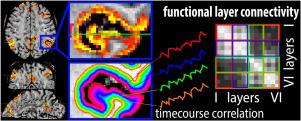Progress in Neurobiology ( IF 6.7 ) Pub Date : 2020-06-05 , DOI: 10.1016/j.pneurobio.2020.101835 Laurentius Huber 1 , Emily S Finn 2 , Yuhui Chai 2 , Rainer Goebel 1 , Rüdiger Stirnberg 3 , Tony Stöcker 4 , Sean Marrett 2 , Kamil Uludag 5 , Seong-Gi Kim 6 , SoHyun Han 6 , Peter A Bandettini 2 , Benedikt A Poser 1

|
Recent methodological advances in fMRI contrast and readout strategies have allowed researchers to approach the mesoscopic spatial regime of cortical layers. This has revolutionized the ability to map cortical information processing within and across brain systems. However, until recently, most layer-fMRI studies have been confined to primary cortices using basic block-design tasks and macro-vascular-contaminated sequence contrasts. To become an established method for user-friendly applicability in neuroscience practice, layer-fMRI acquisition and analysis methods need to be extended to more flexible connectivity-based experiment designs; they must be able to capture subtle changes in brain networks of higher-order cognitive areas, and they should not be spatially biased with unwanted vein signals. In this article, we review the most pressing challenges of layerdependent fMRI for large-scale neuroscientific applicability and describe recently developed acquisition methodologies that can resolve them. In doing so, we review technical tradeoffs and capabilities of modern MR-sequence approaches to achieve measurements that are free of locally unspecific vein signal, with whole-brain coverage, sub-second sampling, high resolutions, and with a combination of those capabilities. The presented approaches provide whole-brain layer-dependent connectivity data that open a new window to investigate brain network connections. We exemplify this by reviewing a number of candidate tools for connectivity analyses that will allow future studies to address new questions in network neuroscience. The considered network analysis tools include: hierarchy mapping, directional connectomics, source-specific connectivity mapping, and network sub-compartmentalization. We conclude: Whole-brain layer-fMRI without large-vessel contamination is applicable for human neuroscience and opens the door to investigate biological mechanisms behind any number of psychological and psychiatric phenomena, such as selective attention, hallucinations and delusions, and even conscious perception.
中文翻译:

依赖层的功能连接方法。
fMRI 对比度和读出策略的最新方法学进展使研究人员能够接近皮质层的介观空间状态。这彻底改变了在大脑系统内和跨大脑系统映射皮层信息处理的能力。然而,直到最近,大多数层功能磁共振成像研究都仅限于使用基本块设计任务和大血管污染序列对比的初级皮质。为了成为神经科学实践中用户友好适用性的既定方法,需要将层 fMRI 采集和分析方法扩展到更灵活的基于连接的实验设计;它们必须能够捕捉到高阶认知区域的大脑网络的细微变化,并且它们不应该因不需要的静脉信号而在空间上产生偏差。在本文中,我们回顾了层依赖 fMRI 在大规模神经科学应用方面最紧迫的挑战,并描述了最近开发的可以解决这些问题的采集方法。在此过程中,我们回顾了现代 MR 序列方法的技术权衡和能力,以实现没有局部非特异性静脉信号的测量,具有全脑覆盖、亚秒级采样、高分辨率以及这些能力的组合。所提出的方法提供了依赖于全脑层的连接数据,为研究大脑网络连接打开了一个新窗口。我们通过回顾一些用于连通性分析的候选工具来举例说明,这些工具将使未来的研究能够解决网络神经科学中的新问题。考虑的网络分析工具包括:层次映射,定向连接组学、源特定连接映射和网络子划分。我们得出结论:没有大血管污染的全脑层功能磁共振成像适用于人类神经科学,并为研究任何数量的心理和精神现象背后的生物学机制打开了大门,例如选择性注意、幻觉和妄想,甚至有意识的感知。











































 京公网安备 11010802027423号
京公网安备 11010802027423号